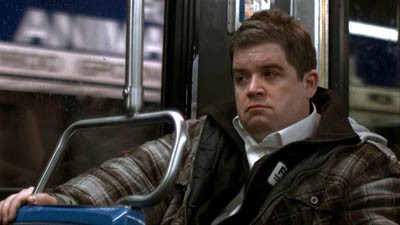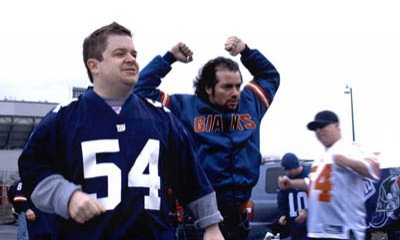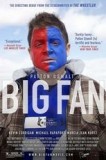| Reviews & Columns |
|
Reviews DVD TV on DVD Blu-ray 4K UHD International DVDs In Theaters Reviews by Studio Video Games Features Collector Series DVDs Easter Egg Database Interviews DVD Talk Radio Feature Articles Columns Anime Talk DVD Savant Horror DVDs The M.O.D. Squad Art House HD Talk Silent DVD
|
DVD Talk Forum |
|
|
| Resources |
|
DVD Price Search Customer Service #'s RCE Info Links |
|
Columns
|
|
|
Big Fan

Paul from Staten Island lives in a world of his own making. A hardcore Giants fan, he spends his every waking minute thinking about the next game. Evenings he locks himself in a little box and collects parking lot fees from people going to and coming from lives he cares nothing about; the rest of the time he is locked in his bedroom in his mother's house listening to sports radio, waiting for his turn to get on the air. If he goes out to do something of his own free will, it's usually something Giants-related. Sundays, he and his best friend Sal (Kevin Corrigan) even head out to the stadium to participate in the parking lot parties before hooking up a TV to their car battery and watching the game. They don't go in, they probably can't afford a ticket. Or maybe it's just preferable to Paul, he stays outside so that he can forever remain inside his safety zone.
Paul is the central character of Big Fan, the directorial debut of Wrestler-scribe Robert D. Siegel, and the Mickey Rourke to his Darren Aronofsky is comedian Patton Oswalt. As a lifelong sci-fi and comic book nerd, Oswalt likely knows a thing or two about obsession, so even if he's not used to wearing a football jersey, the basics of fanaticism are the same regardless of its focus. The actor has seen enough of the dedicated to fully crawl into this guy's skin. Jocks are just nerds of a different stripe. They wear uniforms instead of costumes, they collect stats instead of #1 issues, and in these details lie their happiness.
On a pizza run with Sal one night, Paul's private world bumps into his dream world. He spots his favorite player, Quantrell Bishop (Jonathan Hamm), getting gas across the street. The guys end up following Bishop's SUV to a drug hook-up, though both of them are too square to know that's what it is, and then into Manhattan and a strip club. There, Paul works up the nerve to say hello, but when he lets slip that he's been stalking Bishop all night, the coked-up baller gives him a beatdown. The dream has become a nightmare. Only not for the obvious reasons.
Due to this altercation, Bishop is put on suspension, and Paul's barriers start to crumble. The Giants begin losing, the police are demanding explanations, and Paul's family can't understand why he won't sue for big money. Paul's brother, played by Gino Cafarelli, is a personal injury shyster with a mini-mall trophy wife (Serafina Fiore), and they form the domestic model Paul's weary mother (Marcia Jean Kurtz) wishes her baby boy would follow. Even worse is the fact that Paul's nemesis, Philadelphia Phil (Michael Rappaport), is tearing him apart on talk radio. Paul would do anything to reverse the situation and get Quantrell Bishop back on the field and thus put his manufactured world back in order. It's really just a question of how.

Patton Oswalt has compared Paul from Staten Island to Taxi Driver's Travis Bickle, and there are definitely parallels to be drawn. How sad, though, that since Martin Scorsese and Paul Schrader made that movie just over thirty years ago, this kind of societal antihero has shifted from righteous political anger to defending celebrity and chasing imagined infamy. Paul's not the last moral man in a world he thinks has gone down a path of decadence, he's a victim of pop-culture myopia. Sure, he's devoted wholly to his cause, and arguably, someone who stands his ground when everyone else is fickle and disloyal, but his are the gods of not very much. Travis Bickle's menace has been replaced by boredom. By the time Paul confronts Phil--these two guys are so interchangeable, their names are practically the same--it's not because he sees no other option, it's because he doesn't really have anything else to do. Decked out in the war paint of the rival team, he is a comic mask of tragedy.
I liked Big Fan a lot, but I didn't love it the way so many others have or the way I loved The Wrestler. It works similar territory as that film in that they are both about men who doggedly pursue their passion despite all warnings, but Randy the Ram was a character who was trying to reclaim his past accomplishments rather than riding on someone else's. Paul could have easily been a character in The Wrestler, a devoted follower who drove the Ram to matches in his mother's car. I feel sorry for Paul, but I don't empathize with him. Ending on an "oh, he'll never learn" note makes him pathetic, not heroic. Not that I expect Siegel wanted us to root for Paul any more than Scorsese wanted us to root for Travis Bickle, but we're fascinated by Bickle's righteousness in ways that Paul can't touch.
That's not to really knock Big Fan, either, I'm just thinking about the ways in which films invite us to connect with their stories and their characters. Patton Oswalt is so good in this, I'd say he actually carries the film more than the script. His acting, much of which is internal, not only obliterates the Patton Oswalt persona (I didn't think of KFC food bowls or Uncle Touchy once during the movie) but gives the character depth beyond Paul's own self-awareness. Even before the beating, Paul appears plagued by itches that he cannot name. He is bitter that everyone around him won't just let him be, but the irritation on Oswalt's face also suggests a self-loathing that Paul can never get around.
As a first-time director, Siegel does a solid job of realizing his vision. Big Fan has the same gray, autumnal pallor as The Wrestler. No surprise that the film was shot by Michael Simmonds, who has worked with Ramin Bahrani on all of his movies (most recently Goodbye Solo) and knows a thing or two about capturing real life and all of its grit. Big Fan was shot with the Red One digital camera, and it has a hand-held, grainy look. Natural lighting, sets that aren't overdressed--a kind of neo-neorealsim. Big Fan is best when Siegel and editor Joshua Trank don't push a style and let the shots run long. The fancier quick edits, jumping from close-up to close-up, detail to detail, come off as forced artiness and don't sit well next to the rest.
As we gear into the autumn and the "important" movies that will come out to cleanse our palates of the blockbusters and bait some Oscars, Big Fan is certainly amongst the first must-sees, even with the few complaints I have. It's a portrait of desperation, longing, and delusion, and though its story may not reach out beyond the one man to have bigger implications for the rest of us, that's kind of how Paul from Staten Island would have wanted it anyway.
Jamie S. Rich is a novelist and comic book writer. He is best known for his collaborations with Joelle Jones, including the hardboiled crime comic book You Have Killed Me, the challenging romance 12 Reasons Why I Love Her, and the 2007 prose novel Have You Seen the Horizon Lately?, for which Jones did the cover. All three were published by Oni Press. His most recent projects include the futuristic romance A Boy and a Girl with Natalie Nourigat; Archer Coe and the Thousand Natural Shocks, a loopy crime tale drawn by Dan Christensen; and the horror miniseries Madame Frankenstein, a collaboration with Megan Levens. Follow Rich's blog at Confessions123.com.
|
| Popular Reviews |
| Sponsored Links |
|
|
| Sponsored Links |
|
|
| Release List | Reviews | Shop | Newsletter | Forum | DVD Giveaways | Blu-Ray | Advertise |
|
Copyright 2024 DVDTalk.com All Rights Reserved. Legal Info, Privacy Policy, Terms of Use,
Manage Preferences,
Your Privacy Choices | |||||||











